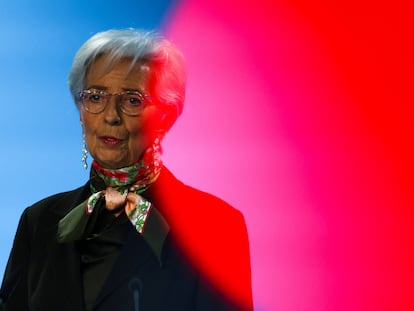Lagarde or the end of sacrilege
After sticking to its half-a-point interest rate hike, the ECB has left further rises up in the air in case the banking turmoil persists or deepens. This is exactly the message that the markets needed

The European Central Bank (ECB) has decided to go ahead with its interest rate hike of half a percentage point despite the banking turmoil that began in the United States due to the collapse of Silicon Valley Bank and later aggravated in Europe with the Credit Suisse crisis. The decision should not be viewed as the hawks banging their fist on the table. Diverting from a rate hike decided since February could have been understood as confirmation of a crisis and as manifest distrust in the support for the struggling Swiss lender made public just a few hours earlier. A decision to raise rates by a quarter point, rather than half as planned, would have created misgivings without making a real difference.
What mattered the most this Thursday in Frankfurt was the message, both the one written in the official statement and the one that Christine Lagarde conveyed in her meeting with reporters. And there were reasons to be fearful of her performance.
Lagarde had suffered some serious setbacks as ECB chief, especially at the beginning of her term. In March 2020, in the midst of the Covid pandemic, she set the markets on fire by saying that the ECB was “not here to close spreads” in reference to members of the monetary union struggling with sovereign debt issues. Lagarde meant to put pressure on governments to take their own measures, but, at critical moments, a central banker must be forceful about putting up firewalls and leave the moralizing for another time. She was forced to rectify that same day in an impromptu interview in which she assured that the ECB was “fully committed to avoid any fragmentation” in bond markets.
This time Lagarde – and the ECB – have passed the test, and it was a difficult one. In a scenario of high pressure from escalating inflation, the Frankfurt meeting left further rate increases up in the air as the ECB continues to monitor whether the banking turmoil persists or deepens. This is the real gesture that the markets needed, beyond a quarter-point rate change up or down. Because what really matters is the day after, and this requires a calm attitude from bankers, especially considering that the shocks of these past few days, and the ensuing mistrust, are already going to result in tighter credit conditions and, in some way, this in itself is going to do part of the thankless job of cooling the economy to combat inflation.
In addition, the ECB has promised to inject as much liquidity as necessary to deal with a financial crisis using “all the necessary monetary policy instruments.” The liquidity programs LTRO (Longer-Term Refinancing Operations) are ready to be activated at any time, and the institution has suggested that it could also resort to the TPI (Transmission Protection Instrument), a tool that allows the ECB to purchase a country’s debt if the borrowing cost differential shoots up (yes, to close the spread, that concept once viewed as a sacrilege). Lagarde did not give any figures: that would have put a price on the crisis.
This premise could also work for the Federal Reserve, which is meeting next week and is expected to raise the price of money by half a percentage point too, although some analysts believe it might be reduced to a quarter-point or even postponed altogether. In welcome news, this time it is the ECB that is setting the pace for the Fed.
Sign up for our weekly newsletter to get more English-language news coverage from EL PAÍS USA Edition
Tu suscripción se está usando en otro dispositivo
¿Quieres añadir otro usuario a tu suscripción?
Si continúas leyendo en este dispositivo, no se podrá leer en el otro.
FlechaTu suscripción se está usando en otro dispositivo y solo puedes acceder a EL PAÍS desde un dispositivo a la vez.
Si quieres compartir tu cuenta, cambia tu suscripción a la modalidad Premium, así podrás añadir otro usuario. Cada uno accederá con su propia cuenta de email, lo que os permitirá personalizar vuestra experiencia en EL PAÍS.
¿Tienes una suscripción de empresa? Accede aquí para contratar más cuentas.
En el caso de no saber quién está usando tu cuenta, te recomendamos cambiar tu contraseña aquí.
Si decides continuar compartiendo tu cuenta, este mensaje se mostrará en tu dispositivo y en el de la otra persona que está usando tu cuenta de forma indefinida, afectando a tu experiencia de lectura. Puedes consultar aquí los términos y condiciones de la suscripción digital.
More information
Archived In
Últimas noticias
Welcome to the post-religion era: The idea of Christianity as the absolute truth has become obsolete
‘I thought you would like it’: The risky sexual practice popularized by TV shows and TikTok
The digitalization of tourism: ‘They promise experiences and gave us the worst possible one’
Mexican peso defies uncertainty with forecasts of a new period of stability in 2026
Most viewed
- Sinaloa Cartel war is taking its toll on Los Chapitos
- Reinhard Genzel, Nobel laureate in physics: ‘One-minute videos will never give you the truth’
- Oona Chaplin: ‘I told James Cameron that I was living in a treehouse and starting a permaculture project with a friend’
- Why the price of coffee has skyrocketed: from Brazilian plantations to specialty coffee houses
- Silver prices are going crazy: This is what’s fueling the rally











































